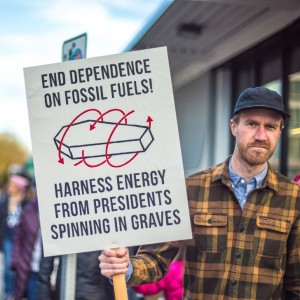Opinion – Editorial by Jim Lyons, New York Times, August 28, 2017
Imagine the businessman Donald Trump putting his real estate up for sale when the market was near the bottom. That’s the equivalent of what President Trump is doing with the oil and gas on our public lands. His misguided move to increase production in a soft energy market is bad for government revenues, not necessary for national security and likely to damage natural resources that millions of Americans use and enjoy.
Interior Secretary Ryan Zinke recently directed the Bureau of Land Management to ramp up sales of oil and gas leases on federal land. He wants leases sold at least every 90 days and drilling permits processed in 30 days, a procedure that, with proper environmental reviews, requires substantially more time. Mr. Zinke is doing this in the name of the Trump initiative for “U.S. energy dominance.”
But what’s the rush?
Global oil and gas supplies are so abundant that these fuels are being produced on less than half of the approximately 27 million acres of public lands under lease to energy companies. Through the 2015 fiscal year, a record 7,950 drilling permits on federal leases were not being used. And last year, the industry bid on less than one-third of the federal acreage offered for lease by the B.L.M., even though the industry identified most of the lands auctioned for energy exploration. What’s not sold can be bought by energy developers at bargain-basement prices — $2 an acre for the next two years.
Even so, federal onshore oil production increased by more than 70 percent from the fiscal years 2006 to 2015, and the number of producing leases on federal land has never been higher. The facts are that the United States already has abundant oil and gas available, the industry has chosen not to drill on leases they already own and is not even bidding on what the government is offering. Even so, America will soon become a net exporter of energy.
“Ramping up the issuance of drilling permits during a time when so many approved permits are not being used would thus seem to be irresponsible,” Mark Squillace, an expert on natural resources law at the University of Colorado Boulder, told a Congressional committee in May.
The B.L.M. manages more than 250 million acres of surface land and 700 million subsurface acres, mostly in the West and Alaska. To meet the Zinke directive, the agency will need to shift its focus from managing public lands for multiple purposes as the law requires — for grazing, mining, water, fish and wildlife, and historic, cultural and recreation values — to an all-out effort to expedite oil and gas lease sales and energy development.
The Trump administration has also directed federal agencies to identify all impediments to oil and gas production — impediments that presumably include environmental reviews of energy projects. That is likely to mean fewer safeguards for the environment and fewer acres for purposes other than energy production.
Oil and gas leases run for 10 years and are often extended. Committing public lands to energy production for so long — whether or not they actually produce oil or gas — means that public use of these lands for nonenergy purposes could be affected for years. That will tie the hands of the next administration as well. And should a new administration decide it wants to manage leased lands for something other than energy, it would have to wait for the leases to expire or buy them back. Renewable energy production could be compromised as well.
Rural communities should be wary of this new initiative. The 2018 budget proposed by President Trump would shift B.L.M. funding for nonenergy programs to oil and gas production. With the bureau’s staff and resources already strained, the Trump budget would force the agency to short-circuit environmental reviews and impact assessments on energy development and curtail priorities important to rural communities that depend on the public lands, like fire prevention, rangeland improvement, conservation of fish and wildlife habitat, and recreation.
A better approach would be to develop an overall strategy to guide energy development to places where conflicts with water, wildlife and recreation are fewer. There would be less harm to public lands and less litigation risk for energy firms.
President Trump’s pursuit of “energy dominance” is likely to amount to a fire sale of oil and gas leases benefiting speculators who pay little up front, hoping to benefit when energy prices rise. Taxpayers would lose and the purported benefits to local communities of greater revenues and more jobs, not unlike the unrealized promises Mr. Trump has made to other communities, are not likely to be realized either. And if national security is the concern, then why not keep our oil and gas in the ground until we need it?
The president’s energy strategy is more likely to damage public-land resources. Rural communities, American taxpayers and our children will pay the price.
>>> Jim Lyons, a research scholar at Yale, was a top official in the Departments of Agriculture and Interior, respectively, during the Clinton and Obama administrations.

